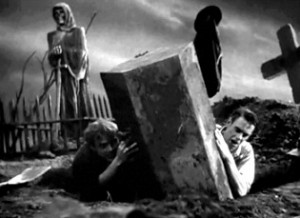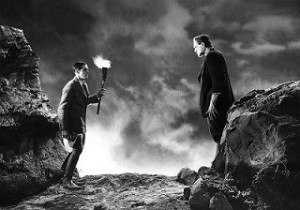There are multiple ways to look at Frankenstein, from the relationship between Henry, Elizabeth and the creature (love triangle?), to the use of the elements (lightning, fire, wind, and water), to the interplay between creature and creator (father and son? Scientist and experiment?). I’m going to focus here on the less obvious, but meaningful motif of bearing witness that runs throughout the movie in various forms, and how looking at it carefully drives a certain interpretation of the film.
Before 1931, movie audiences hadn’t seen a corpse cut down from the gibbet. They hadn’t seen children, thrown in a lake and drowned, soil shoveled onto a casket or a dead body with its brain sitting next to it in a jar. Universal’s Frankenstein changed all of that.
The audience is directly addressed before the story even begins by Edward Van Sloan (Dr. Waldman in the film, and Van Helsing in Universal’s Dracula). Sloan warns the viewer that what they are about to see might thrill, shock, or even horrify them, and invites the audience to leave if they don’t want to “subject their nerves to such a strain.” Giving this choice to the audience creates a sense of forced intimacy: by staying, the audience has agreed to witness the events that are about to unfold. Calling out an event as one to witness validates it, but also highlights the paradigm of witness and event, actor and observer.
 Frankenstein opens with a funeral (a shared event). The name of the deceased – who he is or how he died – isn’t provided, and by this token the event becomes universal. Throughout the scene, as the gravedigger leaves and Henry and Fritz make their appearance, death bears witness in the form of a skeletal, robed figure, set higher and slightly apart. The figure is looking away as Henry and Fritz hurriedly go about their work, and the overall image is one of mischievous children, completing their task while the parent’s attention is elsewhere.
Frankenstein opens with a funeral (a shared event). The name of the deceased – who he is or how he died – isn’t provided, and by this token the event becomes universal. Throughout the scene, as the gravedigger leaves and Henry and Fritz make their appearance, death bears witness in the form of a skeletal, robed figure, set higher and slightly apart. The figure is looking away as Henry and Fritz hurriedly go about their work, and the overall image is one of mischievous children, completing their task while the parent’s attention is elsewhere.
The image of the skeleton continues to be one that bears witness in the earlier parts of the film. The second instance is at Goldstadt Medical College, and takes the form of a skeleton that hangs (and jiggles, to the audience’s amusement) conspicuously over the body and brain that Dr. Waldman is lecturing about, a strange mirroring of the cemetery scene that precedes it: the first is a burial witnessed by mourners, the second is a lecture, attended by students. The funeral scene presents death in a ritual, mystical setting, while at the college it is presented in a dry, clinical one as if the two are – in Frankenstein – destined to collide. The skeleton – the sole witness to Fritz’ crime – startles him by bobbing up and down. Though it starts the next cut stilled, when the gong rings (causing Fritz to drop the normal brain and replace it with the criminal one) the skeleton is moving again, a contrivance hard to attribute to chance, that elevates death from passive witness to borderline participant.
At castle Frankenstein soon after, the scene is no longer one of death but one of normal life, witnessed now by the portraits on the walls of the sitting room (possibly forebears of Henry). Victor (Henry’s brother) and Elizabeth (Henry’s fiance) are themselves acting as witnesses, discussing their observations of Henry as they express their concern for him. The normal pattern of castle life has been disturbed, and Victor and Elizabeth are cast – like the audience – in the role of passive observer. This identification of Victor and Elizabeth with the audience paves the way for what’s to come, when they witness (as the audience’s proxies, and the representatives of normal life) Henry’s terrible experiment. Victor and Elizabeth’s conversation leads them to Dr. Waldman’s office, where they transition away from the normalcy of home and passive observation and into the thread of the story, where death (in the form of a skull on Dr. Waldman’s desk) is once again watching.
Fritz’ fear of the creature’s (Karloff preferred the term “creature” to “monster,” and I’ll stick with that) inert form – despite having surely had a hand in its creation – brings it, though not yet alive, to the fore as an active player. The focus on the creature’s body (a body created out of sewn together corpses), its role of observer, and the absence of skeletal imagery through the rest of the film suggests a transition: the creature is taking from the skeletons/skull the role of death, and that role is moving from a passive to an active one. Henry Frankenstein is creating a paradigm where death, from being a passive witness (like the audience), will become a participant.
The blurring line between life and death as well as witness and participant is hit upon again by Henry himself, when he calls on Elizabeth, Victor, and Dr. Waldman to be his witnesses. The audience, here, stands both with the observers and with Henry, having seen the evolution of both sides. The audience isn’t given the luxury of judgement. Instead we watch, revelling in Henry’s accomplishment but fearing for him, as well.
Neither Henry nor Fritz is on the castle roof: the monster is raised and lightning flashes, but none (save God?) witness the actual moment when the monster is given life. This missing moment leaves the door open to the idea that though Henry is the creature’s creator, there are some secrets even he is not privy to. What we witness as life is given to the monster is not God, but the fumblings of men: the creature’s poor treatment and its portrayal (the genius of Jack Pierce’s make-up was that it left Karloff’s face mostly uncovered, allowing him to act) again puts the audience in the position of not being able to judge the monster truly evil. Despite his deficient brain, his actions can be attributed not to his nature, but rather to the behavior of those who should have nurtured him. There is no moral high ground: put in a position to witness both sides, the audience is allowed to choose neither.
The major events in Frankenstein – a funeral, a lecture, an experiment, a wedding, and finally a mob – are all group  events in which disparate individuals are brought together to witness something important. The wedding of Henry and Elizabeth (and the accompanying celebration by the townsfolk) is one such event. In parallel to it, the audience witnesses the creature unintentionally drowning the child, Maria.
events in which disparate individuals are brought together to witness something important. The wedding of Henry and Elizabeth (and the accompanying celebration by the townsfolk) is one such event. In parallel to it, the audience witnesses the creature unintentionally drowning the child, Maria.
This scene, more than any other, defines the creature as a danger not just to those who would threaten him, but to all who come into contact with him, due to his inability to understand consequences. If the creature is death, the death he represents here is accidental: children left alone to play by the water sometimes drown. This idea is hammered home when the child’s father interrupts the wedding ceremony, his daughter in his arms. “She drowned,” he says at first, and then “she was murdered.” This “flaw” in the film – how does he know that the child was murdered, rather than drowned? – seems to be an intentional conflation of accidental death as murder, personified in the creature. Using this interpretation, the gathering of the mob becomes an embodiment of our rage at what is usually a force of nature.
 The audience surges forward with the mob as it hunts the creature – as the world of the normal takes revenge against death (accidental or otherwise) in their community. We witness a final confrontation between Henry Frankenstein and his creature, and then the former is thrown from the Windmill, and the later assumed to have died – though as with his birth, the moment of his (assumed) death is also off-camera (paving the way, incidentally, for Bride of Frankenstein 4 years later).
The audience surges forward with the mob as it hunts the creature – as the world of the normal takes revenge against death (accidental or otherwise) in their community. We witness a final confrontation between Henry Frankenstein and his creature, and then the former is thrown from the Windmill, and the later assumed to have died – though as with his birth, the moment of his (assumed) death is also off-camera (paving the way, incidentally, for Bride of Frankenstein 4 years later).
James Whale (the director) had a theatrical background, something that manifests in the staging and sets of Frankenstein. The audience is cast as witness to a mythic event, and in parallel the events of the film are witnessed by death (skeletons, skulls), the world of science (Waldman) and normal, everyday life (the paintings on the wall, Victor, Elizabeth, the Baron, the Townsfolk). An interpretation of the monster as death-in-life (intentional or accidental) is ultimately ambiguous: death is not evil, it is a force that we alternately might celebrate or fear, rage against or be fascinated by. Frankenstein presents an opportunity to bear witness to this, and to the fact that death becomes destructive not when we try to understand it, but when we are not prepared to deal with the ramifications of our actions. “We are about to unfold the story of Frankenstein,” says Edward Van Sloan, “a man of science who sought to create a man after his own image without reckoning upon God.” Perhaps Van Sloan’s words here have a slight subversion, in their refusal to directly call out Frankenstein: to fault him not for overreach, but for not anticipating the consequences of his experiment (the “reckoning”). If so, Van Sloan is delivering a message that still rings true, today: that while power over nature may be within our grasp, to enter that territory without full understanding is to risk the creation of monsters.











A most thoughtful analysis of Frankenstein, Steve! I don’t think I ever thought about it through the motif of bearing witness before. I need to re-watch the movie now (and read the book…I can’t believe I still haven’t read the book).
Thanks Teresa! The movie is definitely worth a thoughtful look, though seriously, read the book! The book is very different.